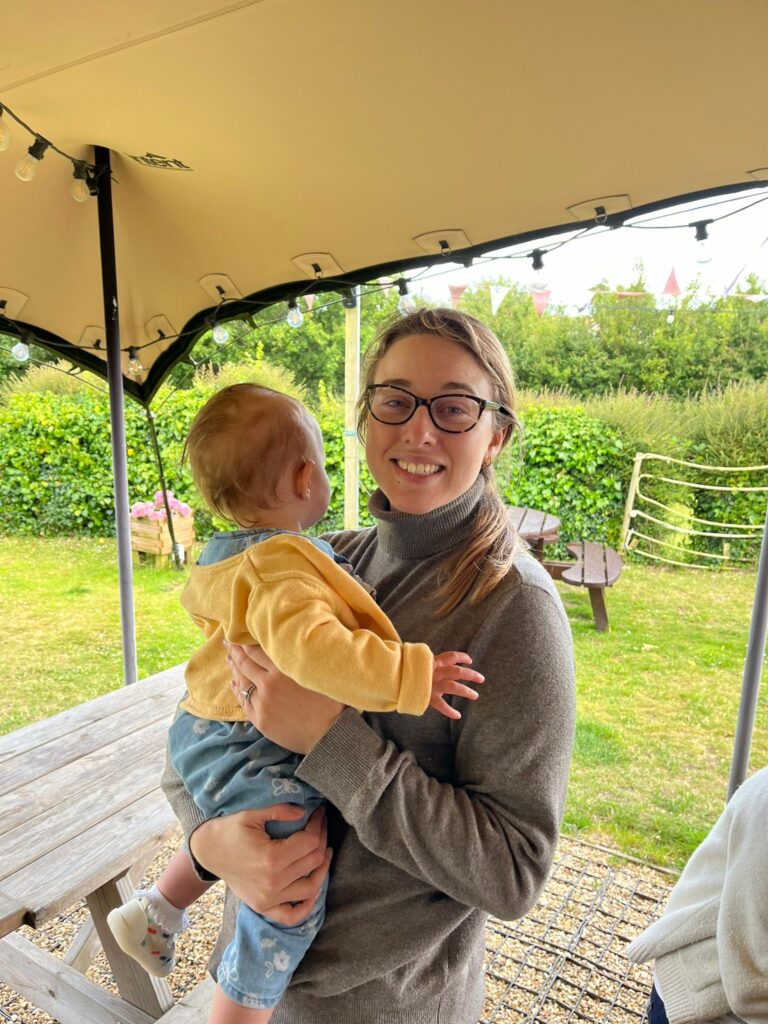After maternity leave, it is not uncommon for mothers to pause their careers or temporarily reduce their working hours, reflecting the difficulty of reconciling work commitments and family life.

The reality is that returning to work and helping a baby adjust to a new routine — whether at nursery, the childminder’s or with other family members — can be challenging. Handling the new mental load isn’t made any easier with broken sleep!
Employers, and their approach to welcoming new parents back to work, can make all the difference during this period. So, how can organizations implement an optimal return-to-work process?
Georgie Leigh recently returned from maternity leave. We caught up with her to find out more about her experience and what helped her transition back to work.
Constance: “I can completely understand how the prospect of returning to work after maternity leave can be a daunting one. Having just gone through it, what are your tips for making it a positive process?”
Georgie: “Creating a smooth return to work starts long before that first day logging back into your Outlook or commuting to the office. It can be daunting to feel completely out of the loop with what’s been going on while you’ve been busy learning how to be a parent and getting to know your baby — particularly in a fast-moving sector like B2B tech communications. It’s worth having a conversation with your manager before maternity leave starts so you’re both on the same page about staying in touch while off work. Everyone will have their own personal preferences, and it’s important that employees feel they can be honest with employers about the extent to which they want to be kept updated (or not).
Constance: “That’s a great point. If you do want to keep in touch while on maternity leave, it’s important that it works for you. Is there anything in particular that you put in place?
Georgie: “For some people, relatively regular emails / WhatsApps with key updates will work; others might find them intrusive, especially if the email (and the corresponding impulse to reply) pops up on a day that is fraught with bad naps, teething or other stresses.
“I decided to set up a Google doc, enabling my manager to drop in key updates and allowing me to check in for any updates and/or respond when it suited me. It hit the right balance for me: I had a clear channel for work updates but knew they wouldn’t “intrude” on time with my daughter. My manager understood the assignment perfectly, essentially becoming a pseudo pen pal during my maternity leave. As a result, I felt caught up with major team and client news, so my first day back wasn’t a complete shock to the system.”
Constance: “I see, it is important to avoid feeling completely lost when you return to the office.
There can also be a certain apprehension about coming back and meeting up with colleagues after such a long time. What was your view on this?”
Georgie: “Staying in touch with your manager is one thing; reconnecting with colleagues is another. Truly inclusive employers don’t forget about their staff who happen to be out of office right now. I was happy to join in for the odd team social or big events like the Christmas party while on maternity leave.
Some individuals may appreciate the invite but opt out of the events, and that’s ok. It’s important these invites don’t go hand-in-hand with any pressure to get back into the work environment before they’re ready. For many, these invites signal that they’re still part of the team.”
Constance: “And did you find any other ways to catch up with the team?”
Georgie: “KIT/SPLIT days offer a more structured opportunity to reconnect with colleagues. If the employee books in any KIT/SPLIT days, it’s helpful for their manager or senior team leads to put some suggestions forward, such as staff meetings or a company all-hands they can attend. Whether KIT days are used for these meetings, to get briefed on big updates or even to start some work tasks, it’s also a useful time for a manager to offer a face-to-face catch up in an informal setting. I really appreciated catching up with my line manager over coffee and chatting through work updates. He totally understood that I was about to go through another big period of adjustment, and he was invested in helping me make it work.”
Constance: “From your perspective, what do employers need to consider when a colleague is returning from extended leave?
Georgie: “It’s a no brainer to set up a call with HR, organize onboarding training for new tools or processes, and ensure returning colleagues have the right tech set up. Don’t forget about the small gestures, though. These can make the difference between a positive or negative first day back.
Constance: “That makes a lot of sense. What was your personal experience of that first day back?”
Georgie: “I was lucky: my team was incredibly welcoming, and I felt excited to get back to work with them all. Seemingly small gestures all factored into this feeling.
Employers should consider what they can do to ensure the individual returning to work feels positive about the change, such as:
- Sending an internal email around in advance of their return, clarifying their job role and responsibilities, and reiterating how excited you are to have them back.
- Organizing a team breakfast or lunch to mark their return to work. Even a card would make that first morning back feel more celebratory!
- Ensuring that colleagues are in the office (if your team works in a hybrid fashion) so the returning staff member benefits from catching up with the team in person on day one.”
Constance; “We were excited to have you back, too! Now that you’re three months back into it all, what has your experience been like?”
Georgie: “I feel very fortunate to work in an environment where I’m given the freedom to manage work demands around the new demands on my time. If I need to log off early for the nursery pick-up or to look after an ill baby and I end up catching up on emails outside of traditional working hours later that day, it isn’t frowned upon. The Hoffman Agency takes its values seriously and trusts staff to care for each other and the work we do. We all want to do great work, and we’ll do our best work if we have the flexibility to work in a way that suits both the individual and the business.”

